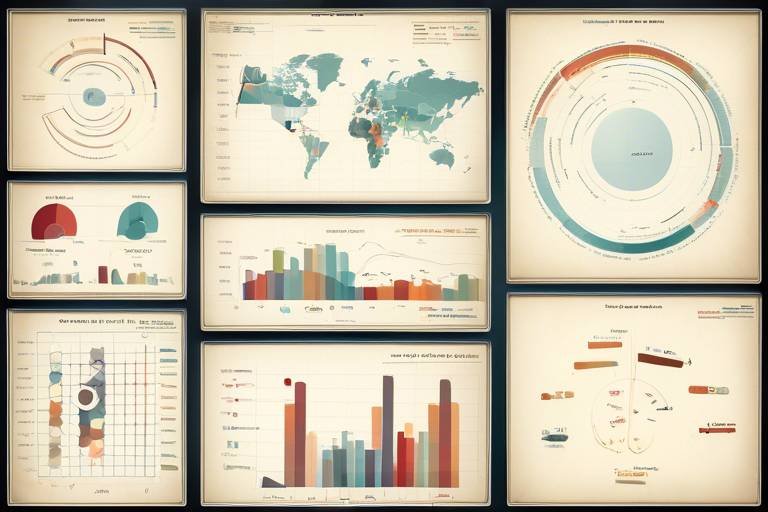Identifying Support and Resistance Levels
In the world of trading, understanding the concepts of support and resistance is akin to having a compass in a dense forest. These levels are crucial in navigating the turbulent waters of the financial markets, helping traders make informed decisions about when to enter or exit a trade. But what exactly are support and resistance levels, and why do they hold such significance in trading strategies? This article dives deep into these concepts, uncovering the methods to identify these levels, their implications, and how to leverage them for successful trading.
Support levels represent the price points where a stock typically stops declining and may even bounce back upwards. Imagine a trampoline: when you jump down, the trampoline pushes you back up. Similarly, support levels act as a cushion for falling prices, preventing them from dropping further. On the other hand, resistance levels are like a ceiling; they are the points where prices tend to halt their upward momentum and may reverse direction. Understanding these dynamics can significantly enhance your trading strategy, allowing you to anticipate market movements and make better decisions.
Throughout this article, we will explore various techniques to identify these critical levels, from analyzing historical data and chart patterns to understanding psychological levels and utilizing technical tools. By the end, you’ll not only grasp the fundamental concepts but also be equipped with practical strategies to apply in your trading endeavors. So, let’s embark on this journey to uncover the mysteries of support and resistance!
Support levels are essential for traders as they indicate potential price floors where buying interest could emerge. To identify these levels, traders often look for historical price points where the stock has previously bounced back. This can be visualized on a price chart, where a series of lows can highlight a strong support level. Think of it as a safety net: when prices fall to this level, it’s like hitting a soft surface that prevents further decline.
Moreover, support levels can be categorized into various types, including:
- Static Support: Fixed price levels determined by historical data.
- Dynamically Moving Support: Levels that shift based on moving averages.
- Trendline Support: Diagonal lines drawn on charts to connect price lows.
Knowing these types can help traders anticipate potential rebounds effectively. As prices approach a support level, traders may consider this a buying opportunity, expecting the price to bounce back. Thus, recognizing and understanding support levels is a vital skill for any trader.
Resistance levels, in contrast, are points where a stock's price tends to stall or reverse after rising. Just as a bird might hit a glass ceiling, stocks often face invisible barriers at resistance levels. Identifying these levels involves looking at historical highs where the price has struggled to break through. Traders often utilize these levels to set selling points, as they anticipate that prices will likely retreat after reaching these heights.
Resistance can also be classified similarly to support:
- Static Resistance: Fixed price levels based on past price action.
- Dynamically Moving Resistance: Levels that change based on moving averages.
- Trendline Resistance: Diagonal lines connecting price highs on charts.
Understanding resistance levels is crucial for traders, as they can help prevent losses by signaling when to exit a trade. Moreover, the interaction between support and resistance levels can create a trading range, offering opportunities for both buying and selling strategies.
Analyzing historical price data is one of the cornerstones of identifying support and resistance levels. By looking at past price movements, traders can forecast potential future levels. A common method is to use a simple chart analysis, where traders mark previous lows and highs, creating a visual representation of these critical levels. This historical context not only provides insight into where prices may reverse but also helps traders gauge the strength of these levels.
Chart patterns are another powerful tool for identifying support and resistance levels. Patterns like head and shoulders, double tops, and triangles can signal potential reversals or continuations in price trends. For instance, a double top pattern often indicates a strong resistance level, while a double bottom can signify robust support. Recognizing these patterns can give traders an edge in predicting market movements.
Volume analysis is essential for understanding the strength of support and resistance levels. High trading volumes at a particular price point can indicate strong interest, reinforcing the significance of that level. Conversely, low volume at a resistance level might suggest a weak barrier, making it more likely for prices to break through. By interpreting volume changes alongside price movements, traders can gain deeper insights into market dynamics.
Psychological levels often play a crucial role in support and resistance due to the collective behavior of traders. These levels are typically whole numbers or round figures, such as $50 or $100, where traders tend to place buy or sell orders. The psychological aspect stems from the tendency of traders to react to these levels, leading to increased buying or selling pressure. Understanding these psychological barriers can provide traders with an additional layer of strategy in their trading plans.
To effectively identify support and resistance levels, traders can utilize various tools and indicators. These tools can enhance analysis and provide clearer signals for trading decisions. Some popular tools include:
Technical indicators, such as moving averages and Bollinger Bands, can help pinpoint support and resistance levels. For instance, a moving average can act as a dynamic support or resistance level, adjusting as prices fluctuate. By integrating these indicators into your trading strategy, you can gain valuable insights into potential market reversals.
Drawing trend lines is a straightforward yet effective method for identifying support and resistance. By connecting price highs or lows, traders can visualize potential levels where prices may reverse. The more times the price touches a trend line without breaking it, the stronger that level becomes. This visual representation can be a game-changer in making informed trading decisions.
Q: What is the difference between support and resistance?
A: Support is a price level where a stock tends to stop falling, while resistance is a level where it tends to stop rising.
Q: How can I identify support and resistance levels?
A: You can identify these levels by analyzing historical price data, chart patterns, and volume analysis.
Q: Are psychological levels important in trading?
A: Yes, psychological levels often influence trader behavior and can act as significant support and resistance points.
Q: What tools can help in identifying these levels?
A: Tools such as technical indicators and trend lines can assist traders in pinpointing support and resistance levels.

Understanding Support Levels
Support levels are like safety nets in the chaotic world of trading. Imagine you’re on a roller coaster, and just as you’re about to plunge down, there’s a sturdy platform that catches you. That’s what support levels do for a stock price. They are specific price points where a stock tends to stop falling and often bounces back up. Recognizing these levels is crucial for traders because they can indicate potential buying opportunities. But how do you identify these elusive support levels? Let’s dive deeper!
One effective method for identifying support levels is through historical price analysis. By looking at past price movements, traders can spot areas where prices have previously rebounded. These historical points can serve as a guide for future price behavior. For example, if a stock has bounced back from $50 three times in the past year, that price might be considered a strong support level. Traders often keep an eye on these levels because they can signify where buying pressure might emerge again.
Another key aspect to consider is the volume of trades at these levels. Volume acts like a heartbeat of the market; it tells you how many traders are interested in buying or selling at a given price. If a stock approaches a support level with high trading volume, it suggests that there’s strong buying interest, making it more likely that the price will hold at that level. Conversely, if the price drops below a support level with low volume, it might indicate a lack of interest, suggesting that the support could be broken.
Additionally, traders often look for chart patterns that can signal support levels. For instance, a double bottom pattern, where the stock price hits a low point, bounces back, and then hits that low again before rising, can be a strong indicator of support. These patterns can help traders visualize where the market sentiment is shifting and where they might want to enter a position.
In summary, understanding support levels is essential for any trader looking to navigate the stock market effectively. By analyzing historical data, paying attention to volume, and recognizing chart patterns, traders can better predict where prices may stabilize. So the next time you’re analyzing a stock, remember to look for those safety nets—your trading strategy might just depend on them!

Understanding Resistance Levels
Resistance levels are critical price points in the trading world where an asset's price tends to stop rising and may even reverse direction. Think of it like a ceiling that a stock struggles to break through. When the price reaches this level, sellers often step in, believing that the asset is overpriced and ready for a pullback. Understanding these levels can be a game changer for traders who want to optimize their entry and exit points.
Identifying resistance levels is not just about spotting a single price; it involves analyzing multiple factors that contribute to these pivotal points. Traders often look at historical price charts to pinpoint where the price has previously struggled to rise. But how do you effectively identify these levels? One way is to observe where the price has peaked in the past. If a stock repeatedly fails to break above a certain price, that price is likely to be a resistance level.
Resistance levels can be classified into two types: static and dynamically changing. Static resistance levels are fixed price points, while dynamic resistance levels change over time, often in line with moving averages. Recognizing the difference can help traders adapt their strategies accordingly. For instance, if a trader identifies a static resistance level at $100, they might consider selling when the price approaches this point, expecting a potential reversal. On the other hand, if they are monitoring a dynamic resistance level, they may need to adjust their strategies as the moving average shifts.
Moreover, resistance levels can also be influenced by market sentiment. For example, during a bullish market, traders may be more willing to push prices higher, but if a significant resistance level is reached, fear and profit-taking can set in, leading to a price drop. This psychological aspect is crucial; traders often react to these levels based on their expectations and experiences, which can create self-fulfilling prophecies.
To sum it up, recognizing resistance levels is about more than just looking at charts; it involves understanding the interplay of historical data, market psychology, and various analytical tools. So, what strategies can traders use to effectively leverage these resistance levels? One effective strategy is to set up alerts when the price approaches a resistance level, allowing traders to prepare for potential reversals or breakouts. Additionally, combining resistance level analysis with other indicators, such as volume and momentum, can provide a more comprehensive view of market dynamics.
In the next section, we will delve into the significance of historical data analysis and how it can enhance your understanding of resistance levels. Stay tuned!

Historical Data Analysis
When it comes to trading, the past is often a powerful predictor of the future. plays a pivotal role in identifying support and resistance levels. By examining how a stock has performed over time, traders can gain valuable insights into potential price movements. Imagine trying to predict the weather without looking at past patterns; it would be nearly impossible! Similarly, understanding historical price movements can provide traders with a clearer picture of where a stock might head next.
One effective method for analyzing historical data is to look for price patterns. These patterns can reveal how a stock has reacted at certain price points in the past. For instance, if a stock repeatedly bounces back after hitting a specific price, that price point is likely to act as a support level in the future. Conversely, if a stock consistently struggles to break through a certain price, that price may serve as a resistance level. This repetitive behavior is akin to a rubber band: it stretches and snaps back at certain points, creating a predictable pattern.
To make this analysis more systematic, traders often utilize charts. A simple line chart can help visualize the historical price movements, making it easier to spot trends and significant levels. For instance, consider the following sample data of a stock's closing prices over a week:
| Date | Closing Price |
|---|---|
| Monday | $50 |
| Tuesday | $52 |
| Wednesday | $51 |
| Thursday | $55 |
| Friday | $53 |
In this example, you can see that the stock's price fluctuated throughout the week. By analyzing these movements, traders can identify that the price around $50 has served as a support level, while $55 appears to be a resistance level. This kind of analysis is not only insightful but essential for developing a robust trading strategy.
Another key aspect of historical data analysis is the examination of volume trends. Volume refers to the number of shares traded during a specific time period and can significantly impact the strength of support and resistance levels. For example, if a stock approaches a resistance level with high trading volume, it may indicate that there is strong interest in that price point, making it less likely for the stock to break through. On the other hand, low volume at a support level might suggest a lack of conviction among traders, potentially leading to a breakdown.
In summary, analyzing historical data is not just about looking at numbers; it's about understanding the story those numbers tell. By identifying patterns, utilizing charts, and considering volume trends, traders can make informed predictions about future price movements. It's like piecing together a puzzle where each historical price point adds depth and clarity to the overall picture.

Chart Patterns
Chart patterns are like the breadcrumbs left on the path of price movement, guiding traders to potential support and resistance levels. These patterns are formed by the price action on charts and can reveal underlying market psychology. Recognizing these patterns can be the difference between a successful trade and a missed opportunity. For instance, when you see a head and shoulders pattern forming, it often signals a reversal point, indicating that the price might hit a resistance level soon. Similarly, a double bottom pattern can suggest a strong support level where the price is likely to bounce back up.
One of the most common chart patterns is the triangle pattern. This pattern is formed when the price moves within converging trend lines, indicating a period of consolidation. Traders often look for breakouts from these triangles to identify potential support or resistance levels. The breakout direction can provide clues about the future price movement. For example, if the price breaks out upwards, it may indicate a new resistance level, while a downward breakout may establish a new support level.
Another important pattern to watch for is the flag and pennant formations. These patterns usually follow a strong price movement and indicate a continuation of that trend. A flag pattern appears as a small rectangle that slopes against the prevailing trend, while a pennant looks like a small triangle. Both patterns suggest that the price is likely to continue in the direction of the previous trend once the pattern completes. Understanding these patterns helps traders anticipate where the price might find support or resistance in the future.
To make the most of chart patterns, traders often combine their analysis with volume trends. For instance, when a breakout occurs from a chart pattern, a significant increase in volume can confirm that the breakout is genuine, making the identified support or resistance levels more reliable. Conversely, if a breakout happens on low volume, it may indicate a lack of conviction, suggesting that the price could easily reverse back to previous levels. Thus, the synergy between chart patterns and volume analysis is crucial for effective trading strategies.
In conclusion, chart patterns serve as a vital tool for traders looking to identify support and resistance levels. By mastering these patterns, you can enhance your market analysis and make more informed trading decisions. Remember, though, that no pattern is foolproof; always use them in conjunction with other analysis tools and indicators to increase your chances of success in the market.
- What are chart patterns? Chart patterns are formations created by price movements on a chart that help traders predict future price behavior.
- How do I identify support and resistance using chart patterns? Look for specific formations like head and shoulders, triangles, or flags, which indicate potential reversal or continuation points.
- Can volume analysis enhance the reliability of chart patterns? Absolutely! An increase in volume during a breakout can confirm the validity of the pattern and the identified levels.
- Are chart patterns always accurate? No pattern is foolproof. It's essential to use them alongside other analysis tools for better accuracy.

Volume Analysis
When it comes to trading, is like the heartbeat of the market; it tells you how alive a stock is at any given moment. Imagine walking into a crowded room; if everyone is talking and moving around, you know there's energy in the air. Similarly, high trading volume can indicate that a stock is experiencing significant interest, which may lead to stronger support or resistance levels. Conversely, when the room is quiet, it might signal a lack of conviction among traders, hinting at weaker price levels.
Understanding how volume interacts with price movements can provide traders with invaluable insights. For instance, if a stock price is rising and the volume is increasing, it suggests that there is strong buying interest, reinforcing the likelihood that the price will continue to rise. On the other hand, if a stock is climbing but the volume is low, it may signal a lack of enthusiasm, indicating that the upward movement might not be sustainable.
To effectively analyze volume, consider the following key points:
- Volume Spikes: Sudden increases in volume can signify important price movements. If a stock breaks through a resistance level with a surge in volume, it often confirms the strength of that breakout.
- Volume Trends: Observing volume trends over time can help traders identify potential reversals. For example, if a stock has been consistently rising but volume starts to decline, it may indicate that the upward momentum is waning.
- Volume and Price Divergence: If the price is moving in one direction while the volume is moving in the opposite direction, it can be a warning sign. This divergence often suggests that the current price trend may not be sustainable.
Moreover, it's crucial to compare the current volume against historical averages. For instance, if the average volume for a stock is 100,000 shares per day and suddenly spikes to 300,000 shares, this could indicate a significant event or news affecting the stock. Traders often use tools like the Volume Moving Average to gauge whether the current volume is above or below normal levels.
In conclusion, is an essential component of understanding support and resistance levels. By paying close attention to volume in relation to price movements, traders can make more informed decisions and enhance their overall trading strategies. It's not just about the price itself; it's about the story the volume tells behind the scenes.

Psychological Levels
When it comes to trading, play a pivotal role that often goes unnoticed by many. These levels are essentially price points that traders perceive as significant, influenced largely by human psychology and behavior. Think of them as the invisible walls in the market that traders collectively believe will either hold or break. For instance, consider a stock that has consistently bounced back at the $50 mark. This isn't just a coincidence; it's a psychological barrier that many traders have recognized and acted upon.
These levels often coincide with round numbers, such as $100, $50, or $10. Why do traders gravitate towards these numbers? It’s simple—people find comfort in round figures. Just like how we tend to round up our expenses, traders do the same with stock prices. This behavior creates clusters of buy and sell orders around these psychological levels, making them crucial for traders to monitor.
Understanding psychological levels can provide traders with a significant edge. They not only indicate where price movements may stall or reverse but also help in formulating strategies. For example, if a stock approaches a psychological resistance level and shows signs of weakness, it could be a signal to sell. Conversely, if it approaches a psychological support level and shows strength, it may be a good time to buy.
To illustrate this concept further, let’s consider a table that summarizes how psychological levels can impact trading decisions:
| Psychological Level | Market Behavior | Trading Strategy |
|---|---|---|
| $100 | Resistance; price often stalls or reverses | Consider selling or taking profits |
| $50 | Support; price tends to bounce back | Consider buying or adding to positions |
| $10 | Psychological barrier; can lead to increased volatility | Monitor closely for breakout opportunities |
In conclusion, recognizing and understanding psychological levels is more than just a trading tactic; it’s about grasping the collective mindset of the market participants. By paying attention to these levels, traders can better anticipate market movements and make more informed decisions. Remember, the market is not just about numbers; it's also about the psychology behind those numbers. So, keep your eyes peeled for these psychological barriers, as they can be the key to unlocking successful trading strategies.
- What are psychological levels in trading? Psychological levels are price points that traders perceive as significant, often influenced by human psychology and behavior.
- How can I identify psychological levels? Look for round numbers and observe where price movements tend to stall or reverse.
- Do psychological levels work in all markets? While they are most commonly observed in stock markets, psychological levels can be relevant in any trading environment, including forex and commodities.

Tools for Identifying Levels
When it comes to trading, having the right tools at your disposal is like having a well-equipped toolbox for a DIY project. You wouldn't attempt to build a house with just a hammer, right? Similarly, identifying support and resistance levels requires a variety of tools and techniques to ensure you're making informed decisions. Let’s dive into some of the most effective tools that traders use to pinpoint these critical levels.
One of the most popular methods among traders is the use of technical indicators. These mathematical calculations, based on price and volume, help traders understand market trends and potential reversal points. For example, moving averages smooth out price data over a specific period, allowing traders to see the overall direction of the market. By observing where the price interacts with these moving averages, traders can identify potential support or resistance levels. It's like having a GPS that guides you through the twists and turns of the market.
Another essential tool is the trend line. Drawing trend lines is a straightforward yet effective way to visualize support and resistance levels. By connecting the highs and lows of price movements, traders can create a visual representation of the market's direction. These lines can act as dynamic support or resistance, helping traders make better decisions. Imagine you're hiking up a mountain; the path you take is guided by the terrain, just as trend lines guide traders through market fluctuations.
In addition to these tools, traders often utilize chart patterns to identify potential levels. Patterns such as head and shoulders, double tops, and flags can indicate where support and resistance may lie. Recognizing these patterns is akin to reading the signs on a road trip; they provide valuable information that can lead to successful trading outcomes.
Volume analysis is another critical component in identifying support and resistance levels. By examining the volume of trades at specific price points, traders can gauge the strength of these levels. High volume near a support level may suggest that it will hold, while low volume could indicate a potential break. It's like listening to the crowd at a concert; if they’re cheering loudly, you know the performance is captivating, but if they’re quiet, something might be off.
To summarize, the tools for identifying support and resistance levels are diverse and multifaceted. From technical indicators and trend lines to chart patterns and volume analysis, each tool offers unique insights that can enhance a trader's strategy. By effectively combining these tools, traders can navigate the complexities of the market with greater confidence and precision.
- What are support and resistance levels? Support levels are price points where a stock tends to stop falling, while resistance levels are where a stock tends to stop rising.
- How can I identify support and resistance levels? You can use tools like technical indicators, trend lines, chart patterns, and volume analysis to identify these levels.
- Why are psychological levels important? Psychological levels often reflect trader behavior and can act as significant support or resistance due to the collective mindset of market participants.
- Can I rely solely on one tool? While one tool can provide insights, combining multiple tools often yields better results in identifying support and resistance levels.

Technical Indicators
When it comes to identifying support and resistance levels in trading, technical indicators are your best friends. These tools provide valuable insights that can help traders make informed decisions. Think of technical indicators as the compass guiding you through the often turbulent waters of the financial markets. They can help you pinpoint where a stock might bounce back or where it might hit a ceiling. But how do you effectively use these indicators to enhance your trading strategies?
One popular technical indicator is the Moving Average (MA). This indicator smooths out price data by creating a constantly updated average price. When traders look at the Simple Moving Average (SMA) or the Exponential Moving Average (EMA), they often notice that these averages can act as dynamic support or resistance levels. For instance, if the price of a stock consistently bounces off its 50-day moving average, that average can be considered a strong support level. Conversely, if the price struggles to break above the 200-day moving average, that level may serve as resistance.
Another vital indicator is the Relative Strength Index (RSI). This momentum oscillator measures the speed and change of price movements, helping traders identify overbought or oversold conditions. When the RSI is above 70, it indicates that a stock might be overbought, suggesting a potential resistance level. On the flip side, an RSI below 30 indicates that a stock might be oversold, hinting at a possible support level. So, keeping an eye on the RSI can provide traders with crucial clues about when to enter or exit trades.
Let's not forget about the Bollinger Bands, another powerful tool in a trader's arsenal. These bands consist of a middle band (the moving average) and two outer bands that represent standard deviations from the average. When prices touch the lower band, it often signals a potential support level, while touching the upper band can indicate a resistance point. Traders frequently use Bollinger Bands in conjunction with other indicators to confirm their analysis and make more strategic decisions.
In addition to these indicators, it's essential to consider Volume. Volume can amplify the effectiveness of technical indicators. For instance, if a stock price approaches a support level with increasing volume, it suggests strong buying interest, reinforcing that support. Conversely, if the price reaches a resistance level with low volume, it may indicate a lack of conviction among sellers, making it more likely that the price will break through that resistance.
To sum it up, technical indicators are indispensable tools for traders looking to identify support and resistance levels. By utilizing indicators like Moving Averages, RSI, and Bollinger Bands, and considering volume, traders can gain a clearer picture of market dynamics. Remember, these indicators are not foolproof, but when used wisely, they can significantly enhance your trading strategies and lead to more successful outcomes.
- What are support and resistance levels?
Support levels are price points where a stock tends to stop falling, while resistance levels are where it tends to stop rising. - How can I identify support and resistance levels?
You can identify these levels through historical data analysis, chart patterns, volume analysis, and technical indicators. - Do technical indicators guarantee success in trading?
No, technical indicators are tools that can help inform your decisions, but they do not guarantee success. - What is the best technical indicator for beginners?
Moving Averages are often recommended for beginners due to their simplicity and effectiveness in identifying trends.

Trend Lines
Trend lines are a fundamental tool in technical analysis that can significantly enhance your trading strategy. They are essentially straight lines drawn on a chart that connect two or more price points, helping to visualize the direction of the market. Imagine trend lines as the guiding rails for a train; they help keep your analysis on track, providing clear signals about potential entry and exit points.
To draw a trend line, you need a minimum of two price points. For an upward trend, connect the lows of the price action, while for a downward trend, connect the highs. The more times a trend line is touched without being broken, the stronger it is considered. This is because the more times the price respects the trend line, the more traders will take it seriously, leading to increased buying or selling pressure when the price approaches that line again.
But how do you know if you're drawing your trend lines correctly? Here are some tips:
- Use multiple time frames: Always analyze trend lines across different time frames to confirm their validity. A trend line that appears strong on a daily chart may not hold up on an hourly chart.
- Look for confluence: If a trend line coincides with a support or resistance level, it becomes even more significant. This is where the magic happens, as multiple indicators align to give you a clearer picture.
- Be flexible: Markets are dynamic, and trend lines should be adjusted as new price data comes in. Don't hesitate to redraw your lines if the price action suggests a change in trend.
Understanding trend lines also involves recognizing when they are broken. A break of a trend line can signal a potential reversal. For instance, if the price breaks a downward trend line, it might indicate a shift to an upward trend, prompting traders to reconsider their positions. This is where the excitement in trading lies—anticipating these shifts can lead to profitable opportunities.
Incorporating trend lines into your trading strategy is not just about drawing lines; it’s about understanding the market's psychology. Traders often react to these lines, creating self-fulfilling prophecies. When many traders see a trend line being tested, they may either buy or sell based on their expectations, which can amplify the price movement. This phenomenon highlights the power of collective behavior in the financial markets.
In conclusion, mastering trend lines is an essential skill for any trader. They provide a straightforward yet powerful way to identify potential support and resistance levels. By understanding how to draw and interpret trend lines effectively, you can enhance your market analysis and make more informed trading decisions. Remember, the key is not just to see the lines but to understand the story they tell about price movement and market sentiment.
1. What is a trend line?
A trend line is a straight line that connects two or more price points on a chart, indicating the direction of the market.
2. How do I draw a trend line?
To draw a trend line, connect the lows for an upward trend or the highs for a downward trend using at least two price points.
3. Why are trend lines important?
Trend lines help traders identify potential support and resistance levels, making them crucial for effective market analysis and trading strategies.
4. How can I confirm the strength of a trend line?
The strength of a trend line can be confirmed by the number of times it has been tested without being broken, as well as its alignment with other support or resistance levels.
5. What does it mean when a trend line is broken?
When a trend line is broken, it can signal a potential reversal in the market trend, prompting traders to reassess their positions.
Frequently Asked Questions
- What are support and resistance levels?
Support and resistance levels are critical price points on a chart where the price tends to stop and reverse direction. Support refers to the price level where a stock tends to stop falling and may bounce back up, while resistance is where a stock tends to stop rising and may drop back down. Understanding these levels can significantly enhance your trading strategy.
- How can I identify support levels?
Identifying support levels involves looking for historical price points where the stock has previously bounced back. You can analyze charts to spot these levels, often marked by multiple price touches without breaking through. Additionally, using tools like trend lines and moving averages can help pinpoint these crucial areas.
- What are psychological levels in trading?
Psychological levels are price points that traders tend to focus on, often ending in round numbers like $50 or $100. These levels can act as support or resistance due to the collective behavior of traders, creating significant trading activity around them. Recognizing these levels can give you an edge in predicting price movements.
- How does volume affect support and resistance?
Volume plays a vital role in confirming support and resistance levels. A high volume at a support level suggests strong buying interest, making it less likely for the price to break below that level. Conversely, high volume at a resistance level indicates strong selling pressure, suggesting the price may not rise above that point.
- What tools can I use to identify support and resistance levels?
There are several tools available for identifying support and resistance levels, including technical indicators like moving averages, Fibonacci retracements, and Bollinger Bands. Additionally, drawing trend lines on your charts can help visualize these levels and make more informed trading decisions.
- Are support and resistance levels always reliable?
While support and resistance levels are useful indicators, they are not foolproof. Market conditions can change rapidly, and factors such as news events or economic reports can lead to price movements that break through these levels. It's essential to use them in conjunction with other analysis methods for better accuracy.
- Can chart patterns help in identifying support and resistance?
Absolutely! Chart patterns like head and shoulders, double tops, and triangles can provide insights into potential support and resistance levels. By recognizing these patterns, traders can anticipate future price movements and make more strategic trading decisions.



















